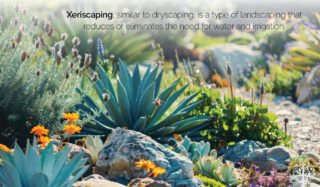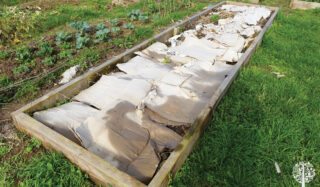I get it. Like the hair on our heads, we’re all very attached to the grass on our lawns. But – as many of us guys know – sometimes we just have to say goodbye to the hair on our head. And the same is true for the grass on our lawns. While many people are seeding or reseeding their lawns this time of year, we encourage you to consider some alternatives.
Why Dryscape?
Xeriscaping, similar to dryscaping, is a type of landscaping that reduces or eliminates the need for water and irrigation. The idea is to replace grass with low-maintenance and drought-tolerant plants, native wildflowers and grasses, or low-growing groundcovers.
The above options are much more pollinator-friendly than standard lawns. In addition to conserving water, they also help save you time and money!
Think about how much time you spend mowing and caring for the lawn, how much money you spend on a lawn mower, hedge trimmers, grass seed, and everything else associated with keeping that large area covered in good-looking green grass.
Yes, the initial setup of a xeriscaped area costs money and takes time. However, once it’s set up, the costs going forward are generally much less—as are the time requirements to maintain it. So, how do you do it?


How NOT to Get Rid of Grass
We never recommend using weed killers to eliminate lawns. These harsh chemicals seep into the soil and enter groundwater, lakes, and streams.
Be careful because some recommended ‘natural’ options, such as using salt and vinegar to remove grass, can also harm other plants, the soil structure, and its microbial life.
We always recommend the regenerative way.
The Regenerative Way: Sheet Mulching
Sheet mulching is the best way to remove grass and build new garden beds. This regenerative technique, also known as sheet composting or lasagna gardening, builds soil, suppresses weeds, and acts as a mulch.


Sheet Mulching with Cardboard and Newspaper
- Start by mowing your lawn as low as possible. Leave the clippings in place for added nitrogen!
- Cover the area with cardboard or non-glossy sheets of newspaper, wetting each layer as you place them to jumpstart decomposition.
- Cover with 12 inches of organic material. For balance, use nitrogen and carbon sources, including manure, coffee grounds, garden clippings, kitchen scraps, autumn leaves, straw, sawdust, and ground bark mulch.
- Top with an excellent quality compost for planting and a layer of mulch.
You can plant into the compost immediately or cover it with mulch and let this lasagna decompose over the winter. In the spring, pull back the mulch and plant some native, low-maintenance groundcovers, wildflowers, or grasses.
Goodbye, boring old lawn! Hello, thriving, low-maintenance, and eco-friendly oasis!

